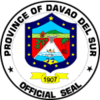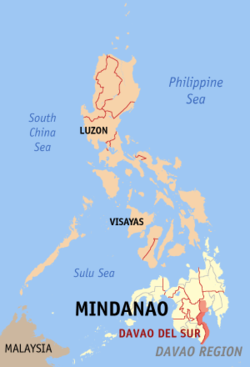- Davao del Sur
-
Davao del Sur — Province — 
SealMap of the Philippines with Davao del Sur highlighted Coordinates: 6°20′N 125°30′E / 6.333°N 125.5°ECoordinates: 6°20′N 125°30′E / 6.333°N 125.5°E Country  Philippines
PhilippinesRegion Davao Region (Region XI) Founded May 8, 1967 Capital Digos City Government – Governor Douglas Ra. Cagas (Nacionalista) – Vice Governor Arsenio Latasa (NPC) Area – Total 4,223.45 km2 (1,630.7 sq mi) Area rank 31st out of 80 Population (2010) – Total 837,146
including independent cities: 2,301,147– Rank 29th out of 80
including independent cities: 10– Density 198.2/km2 (513.3/sq mi) – Density rank 39th out of 80 Divisions – Independent cities 1 – Component cities 1 – Municipalities 14 – Barangays 337
including independent cities: 519– Districts 1st and 2nd districts of Davao del Sur
including independent cities:Time zone PHT (UTC+8) ZIP Code Spoken languages Bagobo, Cebuano, Davaoeño, Tagalog Davao del Sur (Filipino:Timog Dabaw) is a province of the Philippines located in the Davao Region in Mindanao. Its capital is Digos City. The province is bordered by Davao City to the north, and Cotabato, Sultan Kudarat, South Cotabato, and Sarangani to the west. To the east lies the Davao Gulf. It also shares a water border with the Indonesian province of North Sulawesi to the south.
Contents
Geography and Topography
Located in the southeastern corner of the country's southernmost island of Mindanao, the province of Davao del Sur in the north to Sarangani Island in the south. It is bounded by the province of Davao del Norte to the north; the Celebes Sea to the south; North Cotabato, Sultan Kudarat and South Cotabato to the west ; and Davao Gulf to the east. With a land area of 6,377.6 sq.km., the province is composed of sandy beaches and outlying islands; agricultural plains and valleys; rainforests; swamps; rolling hills and mountains including the Philippines' highest peak, Mt. Apo (3,144 meters).
Davaodel Sur enjoys a mild, pleasant climate all year round. Because of its topographical characteristics and geographical location, it is rarely visited by typhoons. There is no pronounced wet or dry season. The coolest months are from November to February with an average temperature of 25 degrees Celsius. during the peak summer months from March to May, temperatures average 28 degrees Celsius but may rise as high as 32 degrees.
People
Davao del Sur is an ethnic mix of Mindanaons, Visayans, Tagalogs, Chinese, Japanese and Spanish with a number of indigenous tribes scattered in the central plains and the western shores of the Davao Gulf. The city of Davao has a population of almost 1,400,000 inhabitants spread across a vast 244,000-hectare land. Bagobo, is the main and official language although English and Filipino are widely spoken. It is the fifth largest city in the Philippines according to population.
Ata people live in some areas of Davao City all the way to Davao del Norte, Compostela Valley and Bukidnon. They are related to the Manobos of Cotabato and include sub-groups such as the Talaingod of the Kapalong forests in Davao del Norte and the Matigsalug. Numbering about 222,000, Ata men wear long-sleeved shirts, carry spears, hunt, log and grow crops. Their womenfolk wear native blouses, "malong" skirts and accessories of brass bracelets and bead necklaces.Mandaya and Mansaka are culturally related groups who are highly musical - playing the five string bamboo guitar, two-string lute, violin, flute, gong, drum and bamboo jew's harp. They are also excellent silversmiths crafting breastplates, jewellery, daggers and knives. The Mandayas are famous for their colorful abaca fiber weaves embroidered with tribal motifs.
In both groups, women generally wear handwoven abaca tube skirts, embroidered blue cotton tops and heavy jewellery. Men sport wide blue or white fringed and embroidered trousers and a loose shirt. Red is a color only for a headman ("bagani") and for women of high status.
Bagobo live in an area that extends from Davao del Sur and South Cotabato to the foot of Mt. Apo and Davao City all the way to the land bordered by the Davao and Pulangi rivers and up to northern Cotobato and southeast Bukidnon. Numbering about 80,000, their traditional costume is woven from abaca fiber and heavily ornamented with beads, shells, metal discs, embroidery and brightly-colored geometric applique. Though Bagobos have the most stunning costumes among the Davao ethnic groups, they wear them only on special occasions. Like the Mandayas and Mansakas, they shave their eyebrows to a thin line and file and blacken their teeth. Bagobo smiths cast little bells which are attached to pouches, bracelets, jackets, anklets and inlaid metal boxes.
Tagacaolos number about 23,000 and occupy the area between the western shores of the gulf and the slopes of Mt. Apo. This is one of the tribes which resisted Muslim conversion and maintained a highland animistic culture.
Kalagans are a Muslim group related to the Tagacaolos. Numbering only about 7,000, they live along the shores of the Davao Gulf.
Mangguangans are now only 3,000. They can be found in Davao del Sur and Davao del Norte.
Art and Culture
The colorful artistic heritage of Davao stems from the rich culture of its tribes. For the Bagobos, aesthetics is the meticulous carving of weapons; the elaborate decoration of inlaid metal boxes with bells; and the ornamentation of their abaca fiber dress with embroidery, shells, beads and metal discs. The Mandayas, on the other hand, have a solid tradition in weaving. To produce their famed coarse textured cloth, abaca fiber is colored with earth dyes and woven on a backstrap loom.
The final product is embroidered with bright-colored threads in geometric patterns. Some elements of tribal folklore are also included in the designs. The Mansakas, together with the Mandayas, are also expert silversmiths. They craft weapons, breastplates and dress accessories. Davao is also a harmonious blend of Christian and Muslim cultures. However, its most stunning cultural aspect is definitely its ethnic art which encompasses music, dance, religious ritual, dress and ornamentation.
Political
Davao del Sur is subdivided into 14 municipalities and 2 cities: 1 independent city and 1 component city. Even though Davao City is part of the province for some statistical purposes, is governed independently from the province.
City/Town Income Classification Population No. of Barangays Founded Davao City Highly-Urbanized 1,464,301 (2010) 184 Town, 1848
City, March 16, 1936Digos City 1st class 145,514 (2007) 26 Town, July 19,1949
City, September 8, 2000Bansalan 1st class 54,246 (2007) 25 October 18, 1952 Don Marcelino 3rd class 39,724 (2009) 15 Hagonoy 2nd class 47,170 (2009) 22 Jose Abad Santos (Trinidad) 2nd class 71,786 (2009) 22 Kiblawan 2nd class 43,054 (2009) 30 Magsaysay 2nd class 47,643 (2009) 22 Malalag 1st class 119,334 (2010) 15 July 2, 1953 Malita 1st class 133,524 (2009) 30 Matanao 2nd class 50,536 (2009) 33 1957 Padada 3rd class 33,446 (2008) 17 Santa Cruz 1st class 100,017 (2010) 18 1948 Santa Maria 2nd class 48,362 (2009) 22 Sarangani 4th class 23,394 (2009) 12 Sulop 3rd class 29,737 (2009) 25 History
In 1942, founded by occupation of the Japanese soldiers landed and entering in the province of Southern Davao.
In 1945, the liberation in Southern Davao by the United States and the Philippine Commonwealth troops was supported by the Davaoeño guerrilla fighters against the Japanese forces beginning to fighting in the Second World War.
External links
Municipalities Bansalan • Don Marcelino • Hagonoy • Jose Abad Santos • Kiblawan • Magsaysay • Malalag • Malita • Matanao • Padada • Santa Cruz • Santa Maria • Sarangani • SulopComponent City Highly urbanized city (Administratively independent from the province, but grouped under Davao del Sur by the National Statistics Office)Categories:
Wikimedia Foundation. 2010.


